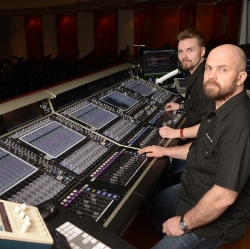
The Finnish National Opera (FNO) was given the rare opportunity to stage a completely original production of Andrew Lloyd Webber’s Phantom of the Opera.
However, the audio system installed at the Helsinki Opera House could not match sound designers Sakke Kiiskis and Stanley Lönnquists vision, prompting the installation a DiGiCo SD7T mixing console.
This is the first time that Phantom of the Opera has been staged in Finland, the first performance taking place in September 2015 and the last this month. The production features a 40 piece orchestra and 44 singers with microphones (some of the choir is not miked), but the chosen console also had to be extremely flexible to handle a wide range of other productions – from classical opera pieces and musicals, to modern dance with 7.1 backing tracks.
“We have a long relationship with DiGiCo and believe their T consoles are the best and most flexible for musical theatre,” says Santtu Sipilä who designed and installed the updated audio system, including the mixing console with the Opera’s sound crew.
“We previously installed SD7Ts in Helsinki’s Swedish Theater and City Theater, as well as specifying them for the production of Kristina från Duvemåla in the Göteborg Opera and the Cirkus arena in Stockholm, Sweden. We have also used an SD10T in the Tampere Theater, southern Finland.”
Santtu worked with Reima Saarinen on the design for Finnish National Opera, specifying a DiGiCo SD7T with EX007 extender wing and six SD-Racks on twin optical loops, plus a Waves SoundGrid system.
“The main challenge was to fulfill all the needs of a modern opera house,” says Santtu. “The venue works in two shifts and there are usually two productions per day in the main hall. For example a classic opera piece will be performed in the morning, then a musical with fully miked orchestra in the evening.
“To accommodate this kind of workload – which also requires backing tracks, effects and virtual sound checking – we use every channel on the SD7T. Both optical loops, Waves and the EX007 are in everyday use. One of the many advantages of the SD7T is that on the larger musicals we can have two operators on the console – one for the orchestra and one doing the vocals.”
Wavemark did the initial SD7T training for the Opera House, as the company was able to do it in Finnish, but DiGiCo product specialist Dave Bigg has also been booked to run a masterclass.
“The opera staff have been very happy with the choice of the SD7T and the possibilities that it offers,” says Santtu. “We have always enjoyed great support from DiGiCo. We have sometimes had unusual questions about large digital systems, but have always had quick answers from them.”
“The overall flexibility of the SD7T has been a great asset to us,” confirms Petteri Laukkanen, deputy head of stage at the Finnish National Opera and Ballet. “The ability to recall complete console and routing setups has provided us with great logistical advantages, as we change things between shows on a very tight schedule. Features like SD7’s theatre software, virtual sound-check capabilities and in-system audio routing to our TV production system, allow us to carry out complex productions with pristine audio quality, in a simple and effective manner.”
